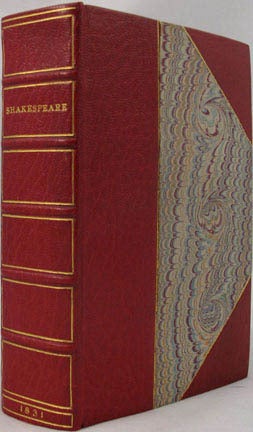THE COMEDIES HISTORIES AND TRAGEDIES OF SHAKESPEARE
(London: William Pickering, 1831).
A BEAUTIFULLY BOUND EARLY PRINTING OF THE MASTER’S WORKS, THIS COPY WITH FINE PROVENANCE, HAVING BEEN OWNED BY AUSTIN DOBSIN. The fine Pickering production of Shakespeare’s plays is still one of the most famous of the early 19th century printings and this copy is especially attractive in fine binding and ownership history.
‘Austin Dobson, was distinguished as both poet and biographer. Those who study his work are struck by its maturity. It was about 1864 that he turned his attention to writing original prose and verse, and some of his earliest work was his best. It was not until 1868 that the appearance of St Paul's, a magazine edited by Anthony Trollope, gaveDobson an opportunity and an audience; and during the next six years he contributed some of his favourite poems, including "Tu Quoque," "A Gentleman of the Old School," "A Dialogue from Plato," and "Une Marquise." Many of his poems in their original form were illustrated—some, indeed, were written to support illustrations.
By the autumn of 1873 Dobson had produced enough verse for a volume, and published Vignettes in Rhyme, which quickly went through three editions. During the period of their appearance in the magazine the poems had received unusual attention, George Eliot, among others, encouraging the anonymous author. The little book immediately introduced him to a larger public. The period was an interesting one for a first appearance, since the air was full of metrical experiment. Swinburne's bold excursions into classical metre had broken new ground; it was hopeless to attempt to compete, and the poets of the day were looking for fresh forms and variations. Early in 1876, a small body of English poets discovered the French forms of Théodore de Banville, Clement Marot and François Villon, and determined to introduce them into English verse.
Austin Dobson, who had already made successful use of the triolet, was at the head of this movement, and in May 1876 he published in The Prodigals the first original ballade written in English. This he followed by English versions of the rondel, rondeau and villanelle. An article in the Cornhill Magazine by Edmund Gosse, "A Plea for Certain Exotic Forms of Verse," appearing in July 1877, simultaneously with Dobson's second volume, Proverbs in Porcelain, drew the general eye to the possibilities and achievements of the movement. The experiment was deemed a success. In 1883 Dobson published Old-World Idylls, which contained some of his most characteristic work. By this time his taste was gradually settling on the period with which it has since become almost exclusively associated; and the spirit of the 18th century was revived in "The Ballad of Beau Brocade" and in "The Story of Rosina", as nowhere else in modern English poetry. In "Beau Brocade", the pictorial quality of his work is at its very best. He has been compared with Randolph Caldecott, with which it has much in common; but Dobson's humour was not so "rollicking" and his portraiture not so broad as that of the illustrator of John Gilpin. His appeal was more intellectual.
After 1885 Dobson was engaged mainly in critical and biographical prose, by which he added considerably to the general knowledge of his favourite 18th century. His biographies of Henry Fielding (1883), Thomas Bewick (1884), Richard Steele (1886), Oliver Goldsmith (1888), Horace Walpole (1890) and William Hogarth (1879-1891-1897-1902-1907) are studies marked alike by assiduous research, sympathetic presentation and sound criticism. In Four Frenchwomen (1890), in the three series of Eighteenth-Century Vignettes (1892-1894-1896), and in The Paladin of Philanthropy (1899), which contain unquestionably his most delicate prose work, the accurate detail of each study is relieved by a charm of expression which could only be attained by a poet. In 1901 he collected his hitherto unpublished poems in a volume entitled Carmina Votiva.’. Item #25030
The fine and very scarce Pickering edition in one volume. This copy WITH FINE PROVENANCE, having come from the library of Austin Dobsin, with his decorative plate and identifying ownership label. Thick 8vo, in a beautiful English binding of three-quarter crimson morocco over feather marbled boards, lined in gilt at the turnovers, the spine with raised bands dividing the compartments which are decorated with gilt framed panels and lettered in gilt in two of the compartments, t.e.g., others untrimmed. [4], 763 pp. A very fine and bright copy, beautifully preserved, the morocco binding in excellent condition and the text-block too, in very fine condition.

